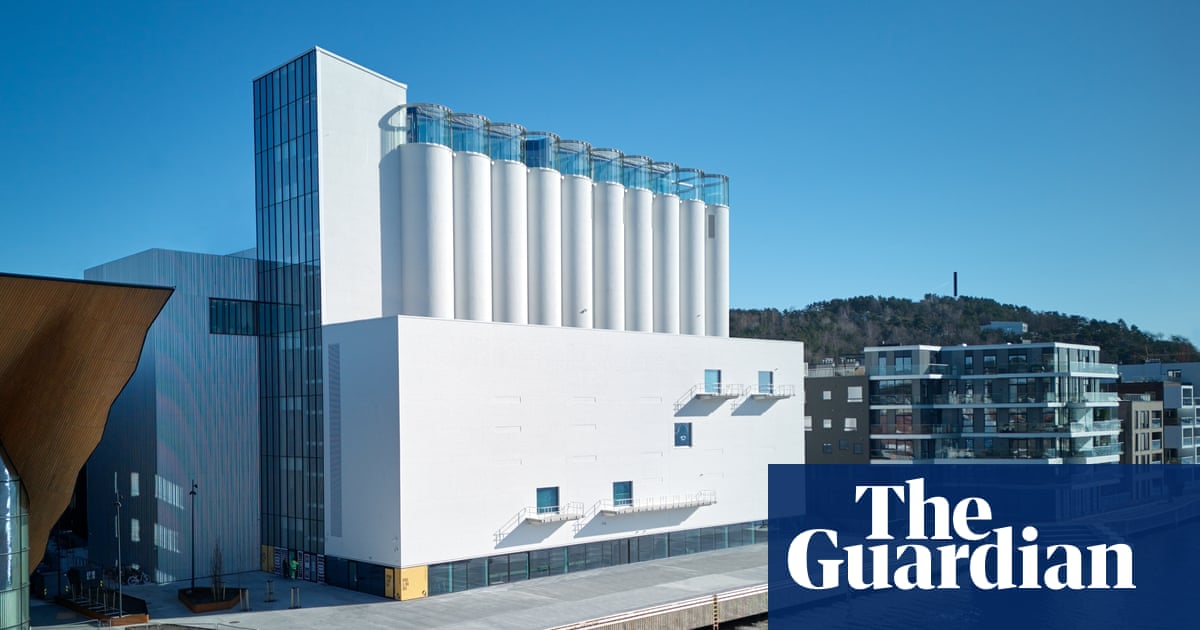If youâve ever wondered what it would feel like to be as insignificant as a kernel of corn, you can now get a good idea in Kristiansand, a city in southern Norway. Standing on the fourth floor of its new Kunstsilo art museum, carved out of an old 1930s grain silo, you can peer down a vertiginous concrete tube that plunges towards huddles of ant-like people below. Or you can look up, through more concrete shafts, towards tiny circles of sky. You can mimic the journey of a grain by climbing a spiral staircase inside one of the cylinders, or test your nerves by walking on a glass-floored terrace suspended over another shaft, floating above a tubular abyss. Itâs a dramatic spatial spectacle â and we havenât even got to the art yet.
Once home to 15,000 tonnes of grain, this mighty concrete mountain is now a repository of the most important collection of Nordic modern art in the world. It is a 5,500-strong haul spanning paintings, drawings, ceramics, sculpture and full-size architectural installations, telling the story of the past century of abstraction, surrealism and expressionism across Norway, Sweden, Finland and Denmark â inside one of the ultimate symbols of modernity itself.
âThe magnificent first fruits of the new age,â is how modernist maestro Le Corbusier described grain silos, to which he dedicated an entire chapter in his 1923 manifesto, Toward a New Architecture. For modernists, silos were the perfect expression of form following function, monuments of storage and symbols of global trade, stripped of surplus ornament. For Bauhaus boss Walter Gropius, they were âalmost as impressive in their monumental power as the buildings of ancient Egyptâ. They still hold an irresistible allure, standing as industrial cathedrals of pure geometric forms. But what should be done with these redundant hulks now?
âIt was a real headache,â says Mathias Bernander, mayor of Kristiansand, where the 40m tall cluster of silos had stood vacant since 2008, occupying a prime waterfront spot. âThe building was protected, but useless.â Designed by one of Norwayâs leading functionalist architects, Arne Korsmo, the 30 concrete cylinders had been listed in 2010, but there was no idea what to do with them. Plans to turn the building into a hotel had proved impossible. âIt was worth nothing,â says Bernander. âIt actually had a minus value, because it was more of a problem than an asset.â
In 2012, a concert hall was built to one side of the silo, in the form of an extravagantly undulating shed. A few years later, a development of expensive waterfront flats started to appear on the other side. But the silo remained, a stubborn relic blocking the waterfront regeneration. Then, as if in a Nordic fairytale, along came one of the cityâs former children, who had since become one of the countryâs wealthiest men. And he was looking for an eye-catching place to house his sprawling collection of art.
âWe walked around town thinking, âWhere would be nice to have our museum?ââ says Nicolai Tangen. âThen there it was â this incredible phallic landmark!â Tangen is no stranger to hunting for meaty opportunities. The 57-year-old made his fortune as a hedge fund manager in London, and now heads the Norwegian sovereign wealth fund, the largest of its kind in the world â lending him the nickname Norwayâs âtrillion-dollar manâ.
He began collecting art in the 1990s, and became so enamoured he took a sabbatical to study for an MA at Londonâs Courtauld Institute in 2003. Amassing a museum-quality horde of Nordic modern art became an obsession, but realising his dream of a place to display it in his home town was no easy ride.
âIt was all hunky dory and positive at first,â says Tangen. âAnd then, bang!â That was the sound of the citizens of Kristiansand learning that they were on the hook for co-funding the project. The building wasnât to be just a private museum, but a joint home for the cityâs existing art collection â a controversial deal that cost the then-mayor his job. Of the £52m total cost, Tangenâs foundation has contributed about £15.5m (half of the total cost came from public sources, the rest from private grants and a bank loan).
âI could have paid for the whole museum,â Tangen says, âbut then it would not have been a gift. For something to be taken care of, people need to participate in the initial investment. If you get a kitten for free, you will look after it less than if you have to pay £10.â
Judging by the crowds at the opening event, most local residents seem thrilled with their new kitten, the controversies a distant memory. People flooded into the ground floor atrium, where the silos have been hollowed out to create a 21-metre high void, and windows look down into the space from landings above.
One silo holds the staircase, beautifully crafted in oak, its curved white steel balustrade bulging into the atrium, while another hugs a curved semicircular sofa on each floor. Evidence of the substantial surgical procedures has been left exposed, with the silosâ concrete edges sawn and ground, revealing chunky aggregate and rusted steel reinforcement bars.
âWe wanted to make a contrast between the rugged silo and the new, precise elements,â says Magnus WÃ¥ge of Barcelona-based Mestres WÃ¥ge Arquitectes, who won the project in an open international competition, with Mendoza Partida and BAX studio. Their first idea was to turn the silos themselves into labyrinthine exhibition spaces, but they found it would have been almost impossible to display paintings. âSo we decided it was better to make the silo into a kind of sculpture at the centre, opening it up into a basilica-like space.â
The galleries are arranged on either side of the momentous void, 3,000 sq metres of conventional white cube space across three levels, housed in a new block on one side, and a rebuilt former storehouse on the other. Mostly windowless, with relatively low ceilings, and separated from the atrium by two sets of sliding glass doors for environmental reasons, they feel a bit lifeless, creating a monotonous sequence relieved only by returning back into the gaping atrium.
It is a similar experience to visiting Thomas Heatherwickâs Zeitz Mocaa museum in Cape Town, also housed in a former grain silo, where the fiendish acrobatic feat of carving an ovoid volume out of the concrete tubes clearly trumped creating the best possible spaces for the display of art. In both buildings, the hollowed-out industrial cadaver is the real star of the show.
For all their claims of âadaptive reuseâ, both projects are also heavily rebuilt. It turns out that ageing concrete silos are not actually capable of being sawn and sliced quite as much as architects might hope. As in Cape Town, the Kristiansand structure had to have a 250mm-thick sleeve of concrete cast around the existing 150mm-thick cylinders, as well as an additional lattice of concrete beams threaded through the tubes to stabilise the structure.
The freshly entombed silos were then insulated and finished with a white plaster render to restore the look of the original structure, only a bit chubbier. No embodied carbon assessment has been carried out, but the environmental argument of âreusingâ the building in this way, when such a substantial amount of new concrete had to be poured, is questionable â especially when the spatial drama of the silos in both cases is confined to the atrium.
Still, itâs easy to forget about all this when youâre up on the roof. While Heatherwickâs building is crowned with an exorbitant boutique hotel, the Kunstsilo summit houses a restaurant with a spectacular roof deck open to all. Here, visitors can sit behind rows of glass fins, arranged to allow a frisson of sea breeze to flow through the gaps, and enjoy views across to the container port the other side of the harbour. You can also gawp at the colossal cruise ships, disgorging thousands of passengers a day into the town â their landing zone eventually to be connected to the museumâs waterfront promenade by a footbridge.
Until now, the chief lure of Norwayâs sunniest city has been a zoo and amusement park, themed around the popular pirate character Captain Sabertooth, which attracts 1.2 million visitors a year. Its former director, Reidar Fuglestad, was poached to head up Kunstsilo, in the hope he might make it an equally popular attraction.
âIt think this project takes Kristiansand from a small town to a big town,â says Tangen. âI donât think it is turning into Bilbao straight away. But I love the idea of having an irritating little museum here putting on the best shows, so that these well-resourced museums in Oslo say, âGeez, whatâs going on down there?ââ



